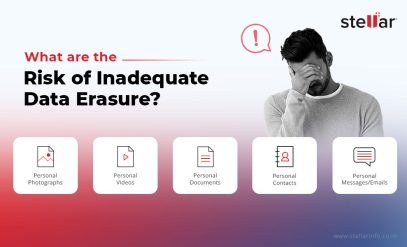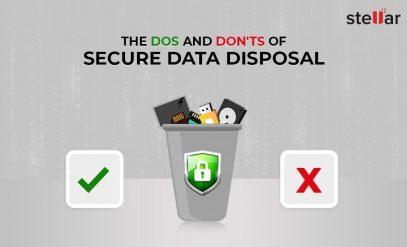Data Erasure in Second-Hand Devices: Ensuring Privacy for Resold Electronics
| Summary: With 1 in 4 data breaches caused by negligence, secure data erasure is crucial. Explore the most trusted methods of data erasure while selling or donating old devices including data erasure software like BitRaser. Safeguard your sensitive information and choose data erasure before passing on devices. |
|---|
- An Oklahoma City resident named Joe Sills came across more than 5,000 Social Security numbers while testing the purchased server and other state computer equipment procured from the auction.
- The server, previously utilized by the state Tax Commission and more recently by the Oklahoma Corporation Commission, likely contained trucking industry data linked to the exposed Social Security numbers.
- As a response, the Corporation Commission began taking measures such as removing hard drives from equipment destined for state auctions to prevent further inadvertent leaks of sensitive information.
The Oklahoma Corporation Commission isn’t the first (or last!) organization to have faced such a data breach.
The cause of the breach in this case was the inadequate data erasure in devices before they were sold off. In fact, 1 in 4 data breaches are known to have been caused by negligence.
A 2019 study by Stellar also highlights the risks related to residual data on secondhand devices.
Key findings:
- Widespread Data Residue: A staggering 71% of the second-hand devices analyzed in the study still contained personally identifiable information (PII), personal data, or business-related information. This means that the majority of people selling their old devices are inadvertently exposing sensitive data.
- Lack of Awareness: The study found that individuals and organizations in India have a poor understanding of the risks associated with not properly erasing data from old storage devices. This lack of awareness is a ticking time bomb for potential cybercrimes.
- Ineffective Data Deletion Methods: One in four devices had been either formatted or had files deleted in an attempt to remove data. However, these methods are not foolproof and often leave residual data.
Don’t want your organization to face a similar predicament? Consider secure data erasure before selling used electronic devices.
Yes, data erasure will come at a cost. But it is worth paying that cost. Here’s why:
- In the Americas, 62% of companies have encountered a data breach in 2021
- The average cost of a data breach in the US amounts to $4.24 million.
- Businesses that have encountered a breach witness a market underperformance of over 15% three years down the line.
Also, that saves you from having to resort to hard drive erasure. Your data remains safe and you can donate/sell your drive – it is the best of both worlds.
Do I need to worry about secure data erasure even if it is a personal device?
Absolutely.
For one: New Device, New Start.
Selling or donating a device is like passing on a legacy. Make sure the next owner gets a fresh start, not your digital baggage. And more importantly, you don’t want your info where it shouldn’t be.
Your embarrassing selfies?
Your pizza orders?
Keep them to yourself.
But I Deleted everything before selling the old hard drive.
That’s not enough. Deleting important files and data doesn’t make them safe from cybercriminals. Data can still be accessed using advanced data recovery methods.
Hard drive erasure is one way to avoid that. Want your device to remain usable? You need Complete Data Erasure.
What does data erasure mean?
How can I ensure data erasure in second-hand devices?
Find answers to all these questions and more in the blog below.
How To Ensure Data Privacy While Donating Or Selling Old Devices?
Individuals and businesses need to understand the right methods of data erasure in secondhand devices. The most commonly used methods aren’t secure. Let’s first understand these methods.
Commonly Used Methods For Data Erasure In Second-Hand Devices
Method 1: Factory Reset
Device Type: Smartphones, tablets, laptops, desktops, smart watches, gaming consoles, smart home devices, routers, cameras (not the external SD cards), fitness trackers
- A factory reset is a built-in feature from most providers that uses software to automatically erase the information stored on the internal memory of the device.
- It’s a quick and easy method for completely deleting personal data, settings, or configurations that you’ve set.
- Factory Reset brings the device to the original system state—or “factory settings.”
- The specific steps for performing a factory reset differ depending on the device’s manufacturer and operating system. However, these steps are generally easy to find either within the device’s settings menu or through a quick search online.
- Manufacturers like Apple, Samsung, and Google provide comprehensive guides on their respective websites.
| Pros | Cons |
|---|---|
| Easy and built-in; no additional software required | Data can be recovered using specialized tools |
| Fast process | May not fully erase data on some devices |
| Does not remove data from SD cards |
Method 2: Encryption and Factory Reset
Device Type: Smartphones, tablets, laptops, desktops, external hard drives, NAS devices, smart TVs, game consoles, servers.
Encryption followed by a factory reset provides an extra layer of security. Even if the reset fails to remove all data, the encryption ensures that the remaining data is unreadable.
Here’s a general description of the steps involved in the encryption and reset process.
- Enable device encryption through the settings. Encryption essentially scrambles your data into a code that can only be deciphered with a specific key.
- Authenticate the action by providing your password, PIN, or biometric verification.
- Perform a factory reset as explained in Method 1. This will erase the encrypted data.
| Pros | Cons |
|---|---|
| Provides added data protection | More complex process |
| Can deter unauthorized access | May not prevent all data recovery methods |
| Suitable for a variety of devices | Can be time-consuming |
Method 3: Remote Wipe
Device Type: Smartphones, tablets, laptops, desktops, NAS devices, servers
What is Remote Wipe?
Remote wipe is a security feature that enables a network administrator or device owner to send a command that remotely erases data from a computing device.
This feature is primarily used when a device is connected to a network and has remote access, ensuring that sensitive data does not fall into the wrong hands.
It also removes data from devices that have changed owners or administrators.
How Does It Work?
- To initiate a remote wipe, the device must be powered on and connected to a network.
- Once the device is confirmed to be connected to the network, the administrator or owner can send a wipe command.
- The specific actions performed by the remote wipe can vary depending on the device’s operating system
- The wipe can selectively delete data in folders, overwrite stored data to prevent forensic recovery, return the device to factory settings, or even render the device completely unusable.
| Pros | Cons |
|---|---|
| Quick and convenient | Requires MDM setup and internet connection |
| Suitable for managing multiple devices | Limited to devices with MDM capabilities |
| Ensures data removal in case of loss or theft | May not be feasible for all businesses |
Secure Methods For Data Erasure In Second-Hand Devices
Here are the secure methods of data erasure for second-hand devices.
Method 4: Professional Data Erasure Services (For Businesses)
Professional Data Erasure Services involve hiring experts to securely wipe or physically destroy devices, ideal for businesses seeking maximum security.
1: Contact a professional data erasure service that specializes in securely wiping or physically destroying devices.
2: Provide the devices to the service provider.
3: Ensure you receive proper documentation or certificates confirming the secure erasure of data.
Methods Employed by Professional Data Erasure Services
- Secure Software-Based Erasure: Uses specialized software to overwrite existing data with zeros or random characters, ensuring that the original data is irretrievable.
- Degaussing: Employs a machine that generates a strong magnetic field to permanently erase all data from magnetic storage devices like hard drives.
- Shredding: Physically shreds the device or its storage medium into small, irrecoverable pieces, making data recovery impossible.
- Crushing: Uses hydraulic presses or similar machinery to physically crush the device, destroying its ability to function and store data.
- Disintegration: Breaks down the device into its base materials, often through industrial processes like incineration, to ensure complete data destruction.
- Cryptographic Erasure: Deletes the encryption keys that make the data readable, effectively rendering the data inaccessible.
- Block Erase: Targets specific blocks of data for erasure, often used for more complex storage solutions like RAID arrays or network-attached storage.
- Firmware-Based Secure Erasure: Uses built-in firmware commands to securely erase data, often used in SSDs and other advanced storage devices.
| Pros | Cons |
|---|---|
| Expert handling for maximum security | Can be expensive depending on quantity |
| Guarantees compliance with data protection regulations | May involve shipping devices to service providers |
| Suitable for various types of devices | Relies on third-party service provider |
Method 5: Data Erasure Software (For Individuals and Businesses)
Data Erasure Software is a specialized tool used to thoroughly remove data from your device, ensuring a secure wipe.
| Pros | Cons |
|---|---|
| Highly effective | |
| Offers multiple erasure options | |
| Can be used for various devices |
BitRaser is a powerful data erasure software designed to securely and permanently wipe data from various devices, such as computers, laptops, smartphones, and storage drives.
Why Choose BitRaser:
BitRaser is preferred for several reasons:
- It supports a wide range of devices and platforms, including Windows, Mac, Android, iOS, and more.
- Bitraser can be used for more than just hard drive erasers. It supports a wide range of devices including:
- It works with or without the Internet.
- BitRaser offers various erasure standards, such as DoD, NATO, and more, catering to different security requirements.
- The software provides an intuitive user interface.
- BitRaser is certified by various industry standards and organizations.
- For businesses dealing with sensitive data, BitRaser helps maintain compliance with data protection regulations like GDPR, HIPAA, etc.
- It generates detailed reports after the erasure process, providing documentation for audit and compliance purposes.
So don’t let your valuable information land in the hands of cybercriminals. Use Bitraser Data Eraser before donating or selling your old devices.
FAQs
1. Why does data not get actually deleted when we delete it?
When data is deleted using standard deletion methods, such as emptying the recycle bin or formatting a drive, it is not physically removed from the storage device. Instead, the space it occupies is marked as available for new data. Until that space is overwritten by new information, the original data can often be recovered using specialized tools.
2. What are the essential practices to be followed by individuals as well as companies before they dispose of their devices?
Before disposing of devices, both individuals and companies should ensure complete data erasure to prevent unauthorized access. Essential practices include: Utilizing Data Erasure Software, as described in the article.
3. Of the five methods discussed in the article, which methods of data erasure are most recommended, and in which situations?
The recommended method of data erasure is utilizing the data erasure Software.
4. In what formats can I save the erasure reports generated by BitRaser?
BitRaser allows you to save erasure reports in PDF, CSV, and XML formats.
5. Do I need separate licenses for different types of drives such as HDD, SSD, and NVMe?
No, a single type of BitRaser license supports the erasure of all types of drives. So whether you want to use it for erasing HDDs, SSDs, NVMe, and more, you can use the same license.







